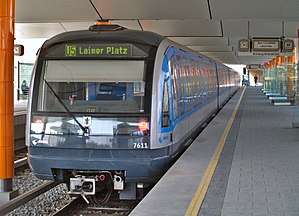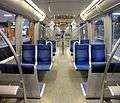MVG Class C
The MVG Class C is an electric multiple unit (EMU) train type operated by the Münchner Verkehrsgesellschaft on the Munich U-Bahn system since 2002.[1] It is the first type of rolling stock on the Munich U-Bahn that consists of more than two cars and features gangways between the individual cars.[1]
| MVG Class C | |
|---|---|
 MVG Class C train at Neuperlach Süd station in April 2009 | |
| In service | 2002–Present |
| Manufacturer | Siemens, Bombardier |
| Designer | Alexander Neumeister |
| Replaced | MVG Class A (A2.1 & A2.2) |
| Constructed | 2000– |
| Number under construction | 120 vehicles (20 sets) |
| Number built | C1: 108 vehicles (18 sets) C2: 150 vehicles (25 sets) |
| Number in service | C1: 102 vehicles (17 sets) C2: 108 vehicles (18 sets) |
| Formation | 6 cars per trainset |
| Fleet numbers | 601–618, 701–721, 722– |
| Capacity | C1: 912 (252 seated) C2: 940 (220 seated) |
| Operator(s) | MVG |
| Specifications | |
| Car body construction | Aluminium |
| Train length | 115,000 mm (377 ft 4 in) |
| Car length | 19,780 mm (64 ft 11 in) (end cars) 18,820 mm (61 ft 9 in) (intermediate cars) |
| Width | 2,900 mm (9 ft 6 in) |
| Height | 3,550 mm (11 ft 8 in) |
| Doors | 3 pairs per side |
| Maximum speed | 80 km/h (50 mph) |
| Weight | 164 t (C1), 180 t (C2) |
| Traction system | Three-phase |
| Power output | C1: 2,400 kW (3,220 hp) C2: 3,360 kW (4,505 hp) |
| Electric system(s) | 750 V DC, 3rd rail |
| Current collection method | Contact shoe |
| Braking system(s) | Electric brake, pneumatic brake, spring accumulator brake |
| Safety system(s) | LZB |
| Coupling system | Scharfenberg (non-electrical) |
| Track gauge | 1,435 mm (4 ft 8 1⁄2 in) |
Design
The first concept intended a three car train.[1] Those plans were later revised to a six car formation, with the exterior and interior designed by Alexander Neumeister.[2] The newer C2 trains are based on the C1, and are also designed by Neumeister. For its design, the C2 trains were awarded a German Design Award,[3] Red Dot Design Award for product design 2013, and Universal Design Consumer Favorite award 2013.[4]
Formation
Every Class C train consists of six cars, which are connected by gangways allowing passengers to walk through the whole train. While the shortest technically possible formation consists of two end cars and one intermediate car, every train in service has been running in a six car formation.[2] Their length of 114 m (374 ft)[N 1] makes them the longest subway trains in Germany.[1]
The Class C was delivered in four batches:
- C1.9: fleet numbers 601–610, delivered from 2001[2]
- C1.10: fleet numbers 611–618, delivered from 2005[2]
- C2.11: fleet numbers 701–721, delivered from 2013
- C2.12: fleet numbers 722–, delivered from 2019[5]
C1 series
| Car | 1 | 2 | 3 | 4 | 5 | 6 |
|---|---|---|---|---|---|---|
| Numbering (sets 601–609) | 660x | 860x | 865x | 875x | 870x | 760x |
| Numbering (sets 610–618) | 661x | 861x | 866x | 876x | 871x | 761x |
| Capacity (seated) | 38 | 44 | 44 | 44 | 44 | 38 |
- Car 1 is at the northern end, and car 6 is at the southern end.
Interior
Seating accommodation consists of longitudinal seating in the end cars and transverse seating bays in the intermediate cars with longitudinal seats near the gangways to the adjacent cars.[2] Only the transverse seats are upholstered; the longitudinal seats are made out of wood. LED panels display the station names, accompanied by automated announcements. The C1 trains have a total capacity of 912 passengers, with 252 seated and 660 standing.[2] The C2.11 trains feature LED interior lighting, LCD passenger information screens, CCTV security cameras and upholstery on all seats.[6] LED stripes on the door edges of the C2 trains show passengers when the doors can be opened and when they are closing. The C2 trains have a total capacity of 940 passengers, with 220 seated and 720 standing.[3] The ceiling-mounted handrails were criticized as being too high, thus only being accessible by tall passengers.[7]
 Transverse seating bays in the intermediate cars
Transverse seating bays in the intermediate cars Longitudinal seating at the gangways
Longitudinal seating at the gangways
Technical specifications
The C1 trains were manufactured jointly by Siemens and Bombardier Transportation, with Siemens building the electrical parts and Bombardier being responsible for the car bodies, bogies, brakes and lighting equipment.[1] The car bodies are made out of aluminium, and the trains are powered by IGBT-controlled[1] three-phase motors. Every axle is powered by one 100 kW motor, bringing the total power output of one C1 train to 2,400 kW (3,220 hp).[2] The C2 trains were manufactured completely by Siemens,[6] and have a power output of 4,500 hp (3,355 kW)[3] with a maximum speed of 80 km/h (50 mph) in passenger service, although their maximum design speed is 90 km/h (55 mph).[7]
History
The first trains, classified as C1.9, were ordered in 1997, with deliveries beginning in 2001.[1] Weak spots on the couplers were discovered during test runs, leading to the trains not being approved by the authorities. The already delivered sets were moved back to Bombardiers Berlin plant for modifications.[2] The first trains entered service in 2002.[1] Eight additional sets, classified as C1.10, were delivered in 2005. Another 21 sets, classified as C2.11, were ordered in 2010[8] with an option of 46 more.[9] Worth 185 million Euro, it is the biggest rolling stock order in the history of the Munich U-Bahn.[6] The first painted bodyshell was unveiled at the Siemens plant in Vienna on October 5, 2012.[10] Originally intended to enter passenger service in 2013, the Technical Authority of Oberbayern didn't gave their permission due to faulty doors and problems regarding the loading gauge.[9] The first C2 trains entered passenger service on June 17, 2016, between Kieferngarten and Garching-Forschungszentrum stations on line U6.[8] The C2 trains then operated on the whole line U6 with a temporary permission, which was due to expire on April 31, 2018.[11] On June 14, 2018, the permission was expanded to line U3, with set 716 being the first C2 train entering passenger service on line U3 on the same day.[12] The last of the 21 C2.11 sets was delivered on November 9, 2018.[13] The first of a further batch of 24 C2 sets arrived in Munich in June 2019.[14] Entry into service is planned for 2020, and deliveries of these sets are scheduled to be finished in 2022.[14] The first C2.12 series trains received their running permission from the Technical Authority of Oberbayern on May 5, 2020.[5]
 A C2.11 train at Studentenstadt station in September 2016
A C2.11 train at Studentenstadt station in September 2016 C2.12 set 724 at Fröttmaning yard in November 2019
C2.12 set 724 at Fröttmaning yard in November 2019
Incidents and accidents
- On May 7, 2015, C1 set 618 ran into a buffer stop on a siding track at Feldmoching station, due to human error.[15] The train was not in revenue service and carried no passengers, only the driver was on board, who suffered a shock. Structural damages on the car bodies of the end car and the adjacent intermediate car resulted in set 618 being permanently removed from regular service to undergo repairs.[15]
- On September 28, 2015, one C1 train broke down south of Holzapfelkreuth station. Another train was used to push the defective C1 train to a siding track at Klinikum Großhadern station. While passing through Großhadern station, the coupling between two cars broke, resulting in the gangway being ripped apart.[16] The cause was found to be insufficient assembly of screws during maintenance by an external company. Six trains had to be temporarily withdrawn and inspected following this incident.[17]
- In September 2017, all C2 trains in service were temporarily withdrawn after electric flash-overs happened at the contact shoes.[9]
Notes
- According to Pischek & Junghardt, the trains have a length of 115,000 mm (377 ft 4 in).[2]
References
- Pabst, Martin (2006). S-Bahn- und U-Bahn-Fahrzeuge in Deutschland [S-Bahn and U-Bahn vehicles in Germany] (in German) (2nd ed.). GeraMond. pp. 19, 72–73. ISBN 3-7654-7366-9.
- Pischek, Wolfgang; Junghardt, Holger (2012). Die Münchner U-Bahn - Geschichte · Streckennetz · Fahrzeuge [The Munich U-Bahn - History · Network · Rolling stock] (in German) (3rd ed.). GeraMond. pp. 60–63, 124. ISBN 978-3-86245-148-7.
- "Das ist Münchens neue Super-U-Bahn" [This is Munich's new super subway]. merkur.de (in German). Münchner Merkur. February 21, 2014. Archived from the original on April 20, 2018. Retrieved April 19, 2018.
- "Auszeichnung: C2-Zug erhält Red-Dot-Award" [Award: C2 train receives Red-Dot-Award]. eurailpress.de (in German). DVV Media Group GmbH / Eurailpress. July 3, 2013. Archived from the original on September 10, 2019. Retrieved April 19, 2018.
- Buchleitner, Frederik (May 6, 2020). "U-Bahn: Zweite C2-Serie darf in den Fahrgastbetrieb" [U-Bahn: Second C2 series allowed to enter passenger service]. Tramreport (in German). Archived from the original on May 6, 2020. Retrieved May 6, 2020.
- "Münchens neue Super-U-Bahn rollt jetzt auf einer Linie" [Munich's new super subway now runs on one line]. merkur.de (in German). Münchner Merkur. June 17, 2016. Archived from the original on April 20, 2018. Retrieved April 19, 2018.
- "München: Neue U-Bahn-Züge mit leuchtenden LED" [Munich: New subway trains with LED lights]. muenchen.tv (in German). München Live TV Fernsehen GmbH & Co.KG. August 26, 2016. Archived from the original on October 19, 2018. Retrieved April 19, 2018.
- "First C2 metro train enters service in München". railwaygazette.com. Railway Gazette. June 17, 2016. Archived from the original on June 20, 2018. Retrieved April 19, 2018.
- Schubert, Andreas (October 27, 2017). "Die MVG braucht dringend U-Bahnen - doch die stehen im Depot" [The MVG desperately needs subway trains - but they are at the depot]. Süddeutsche Zeitung (in German). Archived from the original on September 10, 2019. Retrieved April 19, 2018.
- "München's new metro car unveiled". railwaygazette.com. Railway Gazette. October 8, 2012. Archived from the original on April 20, 2018. Retrieved April 19, 2018.
- "MVG ist weiter unzufrieden mit den neuen U-Bahnen" [MVG is still not satisfied with new subway trains]. abendzeitung-muenchen.de (in German). Abendzeitung München. February 7, 2018. Archived from the original on April 20, 2018. Retrieved April 19, 2018.
- "München" [Munich]. Blickpunkt Straßenbahn (in German). Vol. 4/2018 no. 238. Arbeitsgemeinschaft Blickpunkt Straßenbahn e.V. 2018. pp. 105–106. ISSN 0173-0290.
- "Alle neuen U-Bahnen sind bald einsatzbereit" [All new U-Bahn trains will soon be ready to enter service]. Süddeutsche Zeitung (in German). November 12, 2018. Archived from the original on April 15, 2019. Retrieved January 12, 2019.
- "U-Bahn: 24 neue Züge für München rollen an" [U-Bahn: 24 new trains for Munich] (PDF). swm.de (in German). Stadtwerke München GmbH. June 17, 2019. Archived from the original (PDF) on July 21, 2019. Retrieved July 21, 2019.
- Völklein, Marco (July 6, 2016). "Münchner U-Bahn rauscht auf Prellbock - und niemand soll was mitbekommen" [Munich subway train runs into buffer stop - and nobody should notice]. Süddeutsche Zeitung (in German). Archived from the original on September 10, 2019. Retrieved April 19, 2018.
- Völklein, Marco (September 29, 2015). "Sechs U-Bahnzüge fallen aus" [Six subway trains are cancelled]. Süddeutsche Zeitung (in German). Archived from the original on September 10, 2019. Retrieved April 19, 2018.
- "MVG: Kupplung bei U-Bahn gebrochen" [MVG: subway train coupling broke]. merkur.de (in German). Münchner Merkur. September 15, 2015. Archived from the original on April 20, 2018. Retrieved April 19, 2018.
External links
| Wikimedia Commons has media related to MVG Class C. |
- MVG fleet information (in German)